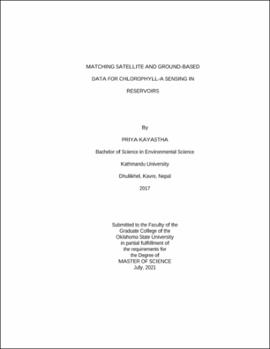| dc.contributor.advisor | Mansaray, Abubakarr | |
| dc.contributor.author | Kayastha, Priya | |
| dc.date.accessioned | 2022-01-21T19:33:47Z | |
| dc.date.available | 2022-01-21T19:33:47Z | |
| dc.date.issued | 2021-07 | |
| dc.identifier.uri | https://hdl.handle.net/11244/333810 | |
| dc.description.abstract | Algal blooms are a major concern due to the adverse health and economic impacts they have on humans, animals, and aquatic ecosystems. Chlorophyll-a, a photosynthetic pigment present in all major groups of algae, has been widely used as an indicator of algal blooms. Studies have used satellite remote sensing to develop Chl-a algorithms by pairing ground-based Chl-a and satellite spectral data that are temporally and spatially coincident. The problem with the development of satellite based Chl-a algorithms is that temporally coincident satellite spectra are not always available due to the mismatch between ground-based sampling and image acquisition dates. It is a common practice to use imagery acquired days before or after ground-based sampling assuming that negligible water quality changes would have occurred if no major limnetic and hydroclimatic activities happened. The literature suggests one day as the ideal temporal disparity between ground-based and satellite data, with some studies suggesting up to 7 days as acceptable. Previous studies have used multiple reservoirs to arrive at these conclusions. It is not clear if the variations observed were due the increasing temporal disparity or the multiple reservoirs. The objective of this study was to delineate the variations caused by increasing time windows and those caused by single versus multiple reservoirs. This study developed regression models using Landsat-5, Landsat-8, and Sentinel-2 for time windows ranging from the same day of satellite and ground-based data collection to eight days apart. We also developed and compared regression statistics for a single reservoir to those of multiple reservoirs. Single bands, band ratios, and spectral derivatives were regressed against Chl-a data from 10 reservoirs of Oklahoma. For the time window, the R^2 values for all three satellites decreased as the time window increased, with Sentinel-2 performing better than Landsat-8 and Landsat-5. The spectral bands present in Sentinel-2 are important predictors of Chl-a. The analysis for single versus multiple reservoirs revealed that the number of reservoirs was not as important as the time window and the satellite resolution for Chl-a sensing. Sentinel-2 and Landsat-8 provided high R^2 values when multiple reservoirs were used. | |
| dc.format | application/pdf | |
| dc.language | en_US | |
| dc.rights | Copyright is held by the author who has granted the Oklahoma State University Library the non-exclusive right to share this material in its institutional repository. Contact Digital Library Services at lib-dls@okstate.edu or 405-744-9161 for the permission policy on the use, reproduction or distribution of this material. | |
| dc.title | Matching satellite and ground-based data for Chlorophyll-a sensing in reservoirs | |
| dc.contributor.committeeMember | Dzialowski, Andrew | |
| dc.contributor.committeeMember | Stoodley, Scott | |
| osu.filename | Kayastha_okstate_0664M_17374.pdf | |
| osu.accesstype | Open Access | |
| dc.type.genre | Thesis | |
| dc.type.material | Text | |
| dc.subject.keywords | algal blooms | |
| dc.subject.keywords | chlorophyll-a | |
| dc.subject.keywords | ground-based sampling | |
| dc.subject.keywords | reservoirs | |
| dc.subject.keywords | satellite remote sensing | |
| dc.subject.keywords | time window | |
| thesis.degree.discipline | Environmental Science | |
| thesis.degree.grantor | Oklahoma State University | |
